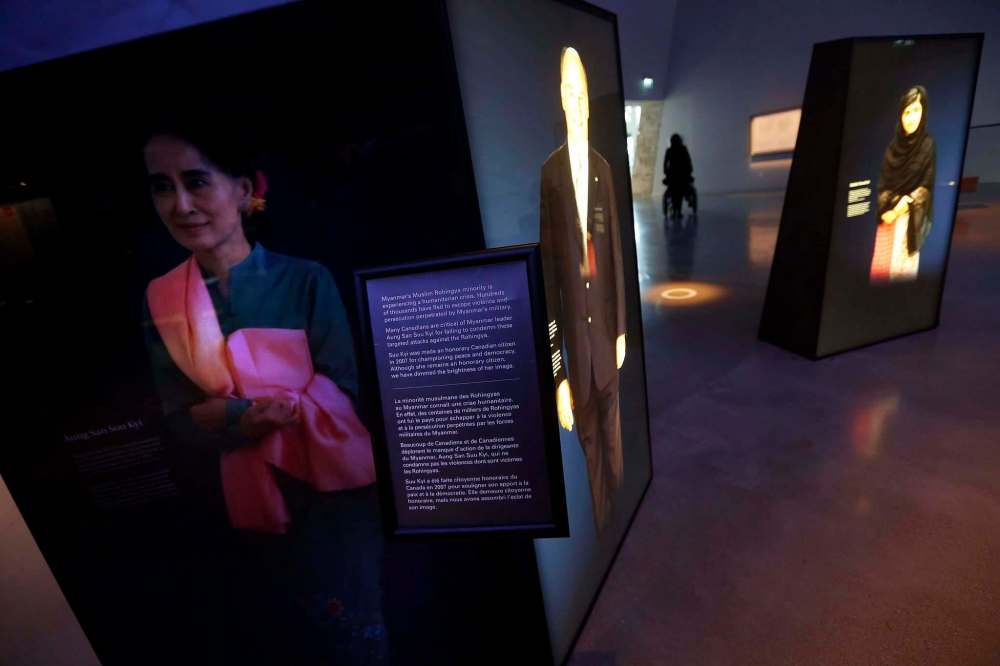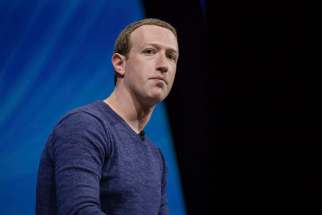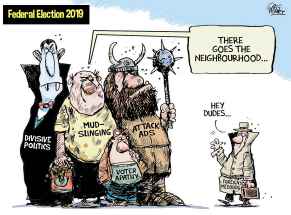Museum carefully weighed response to Aung San Suu Kyi controversy
Read this article for free:
or
Already have an account? Log in here »
To continue reading, please subscribe:
Monthly Digital Subscription
$0 for the first 4 weeks*
- Enjoy unlimited reading on winnipegfreepress.com
- Read the E-Edition, our digital replica newspaper
- Access News Break, our award-winning app
- Play interactive puzzles
*No charge for 4 weeks then price increases to the regular rate of $19.00 plus GST every four weeks. Offer available to new and qualified returning subscribers only. Cancel any time.
Monthly Digital Subscription
$4.75/week*
- Enjoy unlimited reading on winnipegfreepress.com
- Read the E-Edition, our digital replica newspaper
- Access News Break, our award-winning app
- Play interactive puzzles
*Billed as $19 plus GST every four weeks. Cancel any time.
To continue reading, please subscribe:
Add Free Press access to your Brandon Sun subscription for only an additional
$1 for the first 4 weeks*
*Your next subscription payment will increase by $1.00 and you will be charged $16.99 plus GST for four weeks. After four weeks, your payment will increase to $23.99 plus GST every four weeks.
Read unlimited articles for free today:
or
Already have an account? Log in here »
Hey there, time traveller!
This article was published 10/04/2019 (2435 days ago), so information in it may no longer be current.
OTTAWA — Staff at the Canadian Museum for Human Rights spent months figuring out how to respond to the controversy surrounding its prominent display of Aung San Suu Kyi in late 2017, internal documents show.
The Free Press has learned that as a result of that controversy, the museum will launch an exhibit in June that will highlight Myanmar’s persecuted Rohingya minority.
Some 900 pages of records obtained through an access-to-information request show hundreds of emails and dozens of meetings as the museum carefully crafted its response.
“We are vulnerable on this issue,” wrote a public relations official to her colleagues.
In August 2017, international observers documented incidents in which the army of Myanmar (formerly Burma) burned the villages of ethnic Rohingya. Thousands were killed in the violent attacks and at least 700,000 fled to neighbouring Bangladesh. A United Nations official called the events a “textbook example of ethnic cleansing.”

At the time, Suu Kyi had been hailed as a defender of democracy, enduring 15 years of house arrest for her peaceful opposition to authoritarian rule. Canada bestowed honorary citizenship on Suu Kyi in 2007, and the museum displayed a life-sized image of her among the five other honorary Canadian citizens.
But as Myanmar’s de facto ruler, Suu Kyi played down the atrocities. In July 2018, the Winnipeg museum dimmed the lights that shone on her portrait.
“It was a challenging issue for us to deal with for sure — but we do deal with a lot of challenging issues,” said head curator Jodi Giesbrecht on Tuesday.
While visitor logs and online emails urged the museum to remove Suu Kyi from the museum entirely, staff sought more time to consider the best response.
On social media, the museum asked the public to weigh in. The issue was flagged in a quarterly meeting with Mayor Brian Bowman, while officials at the federal Canadian Heritage department were kept in the loop.
Records show meticulous attention to phrasing
Internal documents show museum staff made dozens of small tweaks to their messaging about Aung San Suu Kyi.
Staff debated tone and pondered which words to use in Facebook posts, tweets and eventually the signage that was added to Suu Kyi’s display. Here are some examples:
- “Are we jumping the gun on calling this a genocide?”
- “I’m not sure we should use emotive adjectives like ‘appalling’ instead of more museum-ish language.”
- “Should we be more specific? They have been (hunted) down, assassinated, disappeared, raped, burnt alive, etc. The brutality of the persecution is worth noting.”
- ”We’re a bit passive in saying the Rohingya are experiencing a humanitarian crisis.”
- “Myanmar is the name given to the country by the military junta. Burma is the name used by most activists and also the community. I can ask the curatorial committee how they would refer to the country.”
Head curator Jodi Giesbrecht said staff members are careful about every word that appears in the museum and on its social-media accounts.
“People trust museums to be authoritative, responsible sources of accurate information,” she said.
“Human rights is a challenging subject and it’s one on which people have different points of view and perspectives. And so, when we do put that much thought into this word or that word, we really are trying to think of all those different perspectives.”
Documents show dozens of edits to small blocks of text for social media, with staff debating how much detail to include, and whether their words were strong enough. Some debated whether the term “genocide” was appropriate.
Staff ordered an internal review of how information about the Rohingya is displayed. Last fall, the museum held a public discussion about the atrocities.
“We really wanted to take a multi-pronged approach,” Giesbrecht said. “Different areas of the museum are able to be responsive in different ways.”
Raees Ahmed, an Ottawa activist who used to live in Winnipeg, said the museum was much more responsive than ones he reached out to in the United States.
Ahmed recounted hours-long meetings senior CMHR officials held with Rohingya people in Canada, to understand what to do about the Suu Kyi display.
“I must give credit to the museum for setting the stage, for being at the forefront of taking action,” Ahmed said.
In March 2018, a staff member proposed a temporary exhibit to look at the plight of the Rohingya.
The museum got largely positive attention over its July 2018 decision to dim Suu Kyi’s portrait, while some questioned what had taken so long. An analysis showed that after the change, more visitors went to that part of the exhibit. They also lingered longer.
“They were quicker to act than other civil societies,” said Ahmed, noting that Parliament revoked Suu Kyi’s citizenship months later, and universities cancelled honorary degrees that had been given to her.
The museum also dealt with media queries from South Asia, and scathing letters from people who said they had roots in Myanmar.
One accused the Winnipeg museum of “targeting of a female politician because of a strong Muslim lobby group,” and claimed the atrocities were exaggerated.
“We have a role to play in promoting education and dialogue and when you keep that end goal in sight, some of those challenges become more manageable,” said Giesbrecht, who personally responded to people who made such claims.
Others called the Rohingya “thugs” and “cockroaches.” Giesbrecht said she didn’t respond to those comments because people weren’t interested in a dialogue.
“On social media, the tone is often a bit more belligerent,” said Giesbrecht.
In June, the museum will launch a temporary exhibit named Time to Act: Rohingya Voices. It will feature images from photographer Kevin Frayer, a former Winnipegger, who documented the 2017 events.
It will also feature video interviews museum staff conducted across Canada with Rohingya immigrants.
Ahmed helped interpret as staffers conducted interviews from people who recounted everything from surviving human trafficking to building a new life in Canada. Making the videos and gathering cultural artifacts, which will be displayed, delayed the project’s launch from last fall until June.
“The community feels it has participated, which I believe is essential in a human rights museum,” Ahmed said. “It makes it even richer.”
dylan.robertson@freepress.mb.ca
Excerpt of CMHR records on Myanmar-Rohingya controversy and exhibit
History
Updated on Thursday, April 11, 2019 2:07 PM CDT: Adds missing text from factbox.









